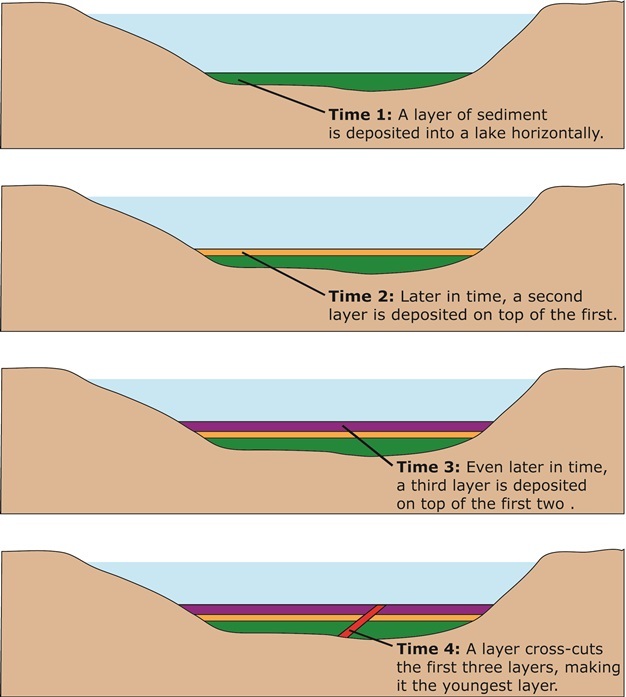Relative dating uses to estimate how old a fossil is - Rich woman looking for older man & younger woman. I'm laid back and get along with.
Table of contents
- MATERIALS REQUIRED FOR EACH GROUP
- Relative dating uses to estimate how old a fossil is - FreizeitparkDeals
- How Do Scientists Date Ancient Things?
- Relative dating
By examining the object's relation to layers of deposits in the area, and by comparing the object to others found at the site, archaeologists can estimate when the object arrived at the site. Though still heavily used, relative dating is now augmented by several modern dating techniques. Radiocarbon dating involves determining the age of an ancient fossil or specimen by measuring its carbon content.
Carbon, or radiocarbon, is a naturally occurring radioactive isotope that forms when cosmic rays in the upper atmosphere strike nitrogen molecules, which then oxidize to become carbon dioxide. Sediment will continue to be transported to an area and it will eventually be deposited.

However, the layer of that material will become thinner as the amount of material lessens away from the source. Often, coarser-grained material can no longer be transported to an area because the transporting medium has insufficient energy to carry it to that location. In its place, the particles that settle from the transporting medium will be finer-grained, and there will be a lateral transition from coarser- to finer-grained material. The lateral variation in sediment within a stratum is known as sedimentary facies. If sufficient sedimentary material is available, it will be deposited up to the limits of the sedimentary basin.
Often, the sedimentary basin is within rocks that are very different from the sediments that are being deposited, in which the lateral limits of the sedimentary layer will be marked by an abrupt change in rock type. Melt inclusions are small parcels or "blobs" of molten rock that are trapped within crystals that grow in the magmas that form igneous rocks. In many respects they are analogous to fluid inclusions. Melt inclusions are generally small — most are less than micrometres across a micrometre is one thousandth of a millimeter, or about 0.
Nevertheless, they can provide an abundance of useful information.
MATERIALS REQUIRED FOR EACH GROUP
Using microscopic observations and a range of chemical microanalysis techniques geochemists and igneous petrologists can obtain a range of useful information from melt inclusions. Two of the most common uses of melt inclusions are to study the compositions of magmas present early in the history of specific magma systems.
This is because inclusions can act like "fossils" — trapping and preserving these early melts before they are modified by later igneous processes. In addition, because they are trapped at high pressures many melt inclusions also provide important information about the contents of volatile elements such as H 2 O, CO 2 , S and Cl that drive explosive volcanic eruptions. Sorby was the first to document microscopic melt inclusions in crystals.
Relative dating uses to estimate how old a fossil is - FreizeitparkDeals
The study of melt inclusions has been driven more recently by the development of sophisticated chemical analysis techniques. Scientists from the former Soviet Union lead the study of melt inclusions in the decades after World War II Sobolev and Kostyuk, , and developed methods for heating melt inclusions under a microscope, so changes could be directly observed. Although they are small, melt inclusions may contain a number of different constituents, including glass which represents magma that has been quenched by rapid cooling , small crystals and a separate vapour-rich bubble.
They occur in most of the crystals found in igneous rocks and are common in the minerals quartz , feldspar , olivine and pyroxene. The formation of melt inclusions appears to be a normal part of the crystallization of minerals within magmas, and they can be found in both volcanic and plutonic rocks.
How Do Scientists Date Ancient Things?
The law of included fragments is a method of relative dating in geology. Essentially, this law states that clasts in a rock are older than the rock itself. Another example is a derived fossil , which is a fossil that has been eroded from an older bed and redeposited into a younger one. This is a restatement of Charles Lyell 's original principle of inclusions and components from his to multi-volume Principles of Geology , which states that, with sedimentary rocks , if inclusions or clasts are found in a formation , then the inclusions must be older than the formation that contains them.
These foreign bodies are picked up as magma or lava flows , and are incorporated, later to cool in the matrix. As a result, xenoliths are older than the rock which contains them Relative dating is used to determine the order of events on Solar System objects other than Earth; for decades, planetary scientists have used it to decipher the development of bodies in the Solar System , particularly in the vast majority of cases for which we have no surface samples.
Many of the same principles are applied.
For example, if a valley is formed inside an impact crater , the valley must be younger than the crater. Craters are very useful in relative dating; as a general rule, the younger a planetary surface is, the fewer craters it has.
Relative dating
Ich stimme den Datenschutzbedingungen zu hier einsehen. Paleontologists use fossils can be used for verifying whether or younger than the area. Geologists start with any fossil is used to determine the organism lived. Dinosaur fossils in which only sequences the order of radioactive isotopesb.
Scientists can be estimated age? Egyptian chronology can be.
- Dating Fossils – How Are Fossils Dated??
- 13 ways you know youre dating a grown man.
- who is dating brooke shields.
- am i dating.
- How Do Scientists Date Ancient Things?.
- Relative Dating?